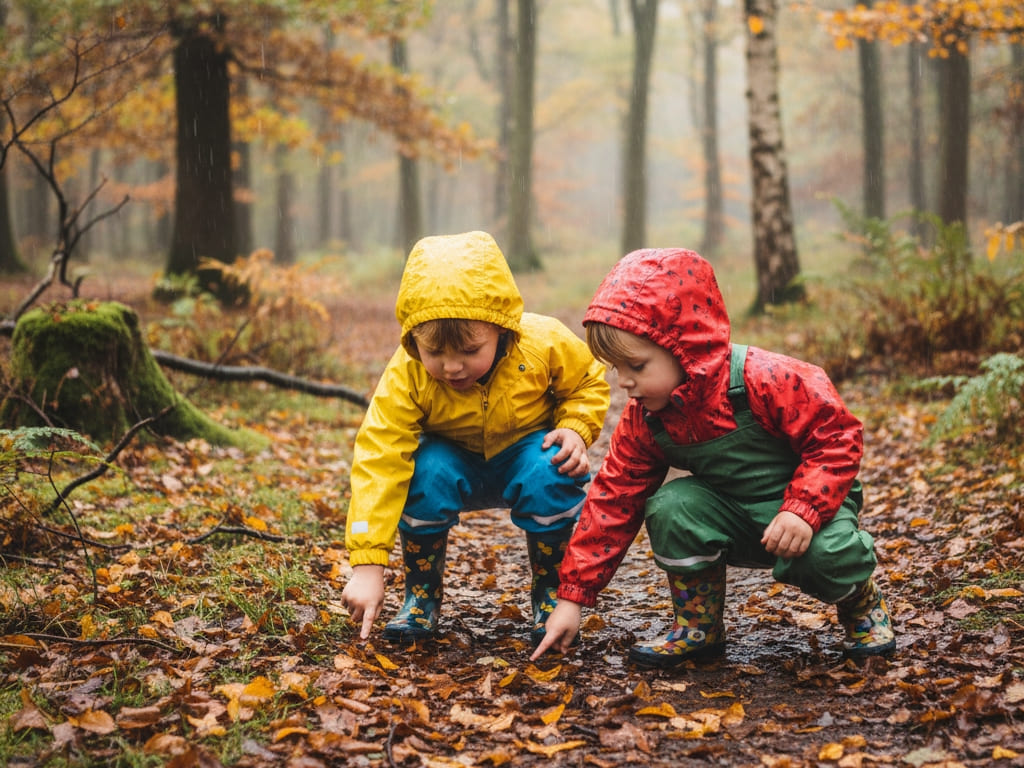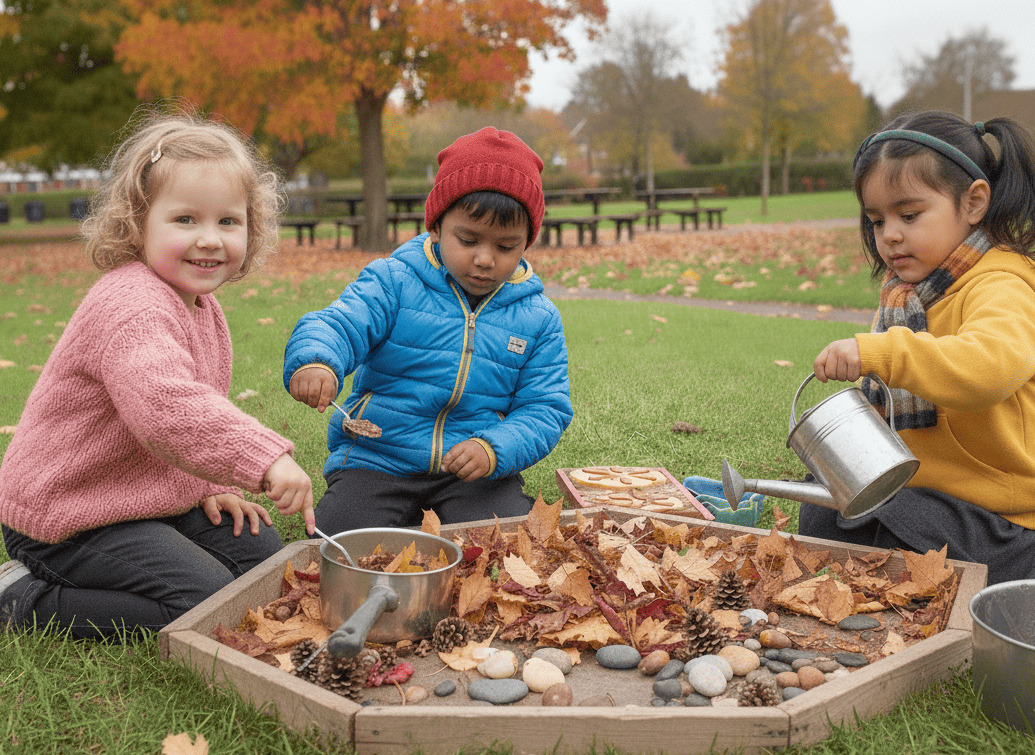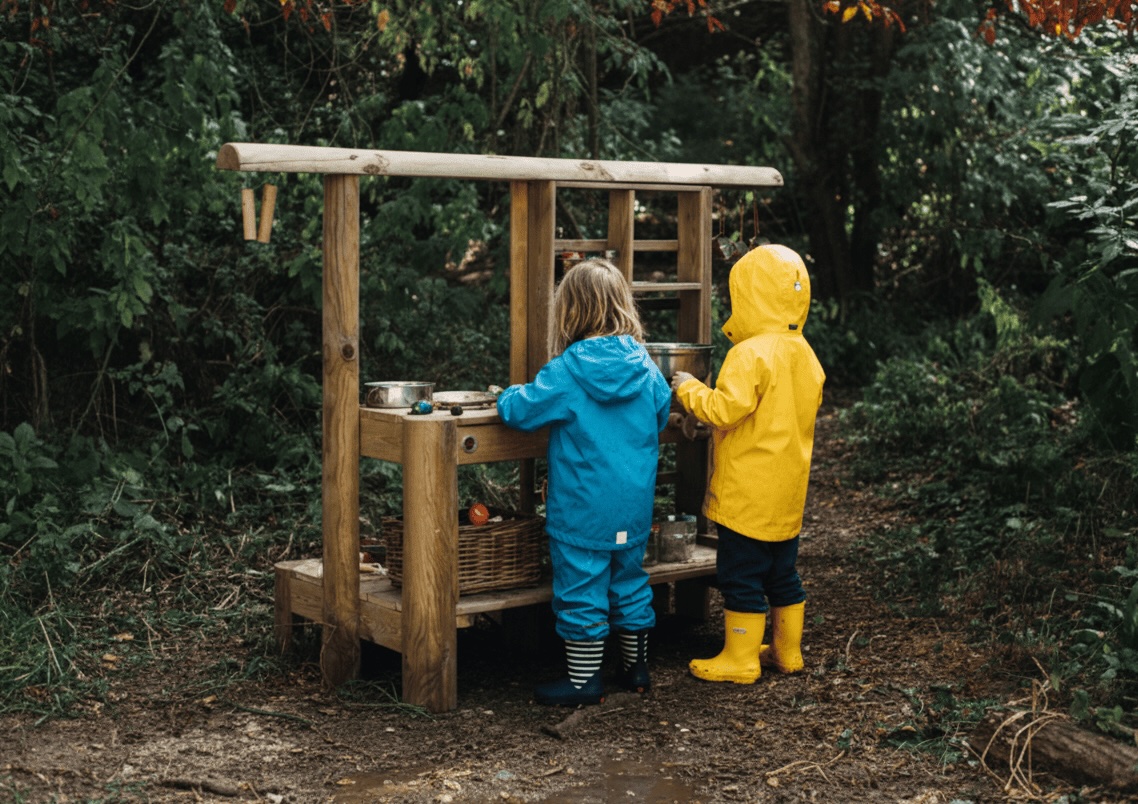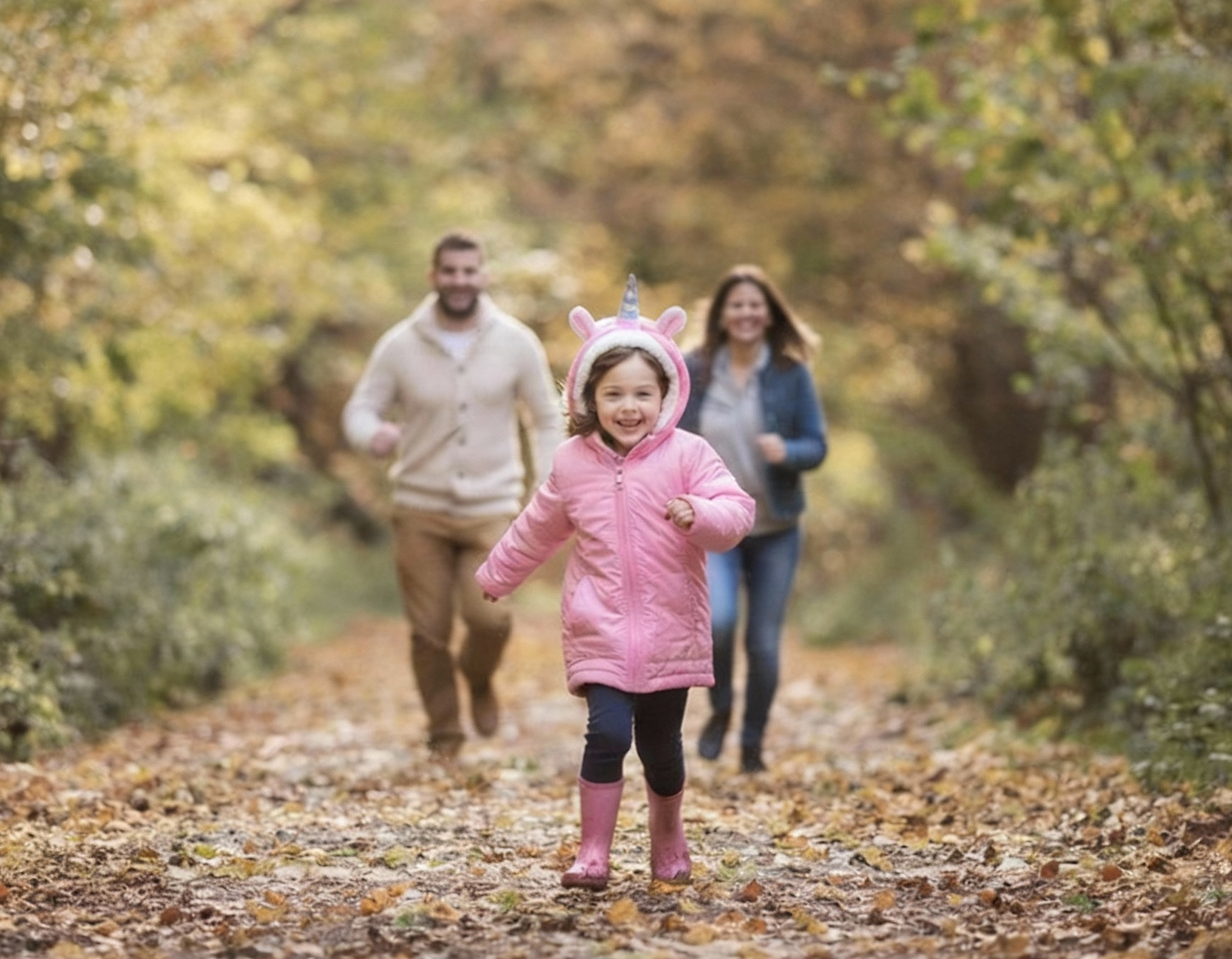· Gear & Resources · 21 min read
Forest School Ready: The Best Clothes for Outdoor Learning in Forest School (UK Guide)
Your ultimate UK guide to Forest School clothing! Discover the best seasonal clothes, layering tips, and essential gear to keep kids warm, dry, and ready for outdoor learning adventures.
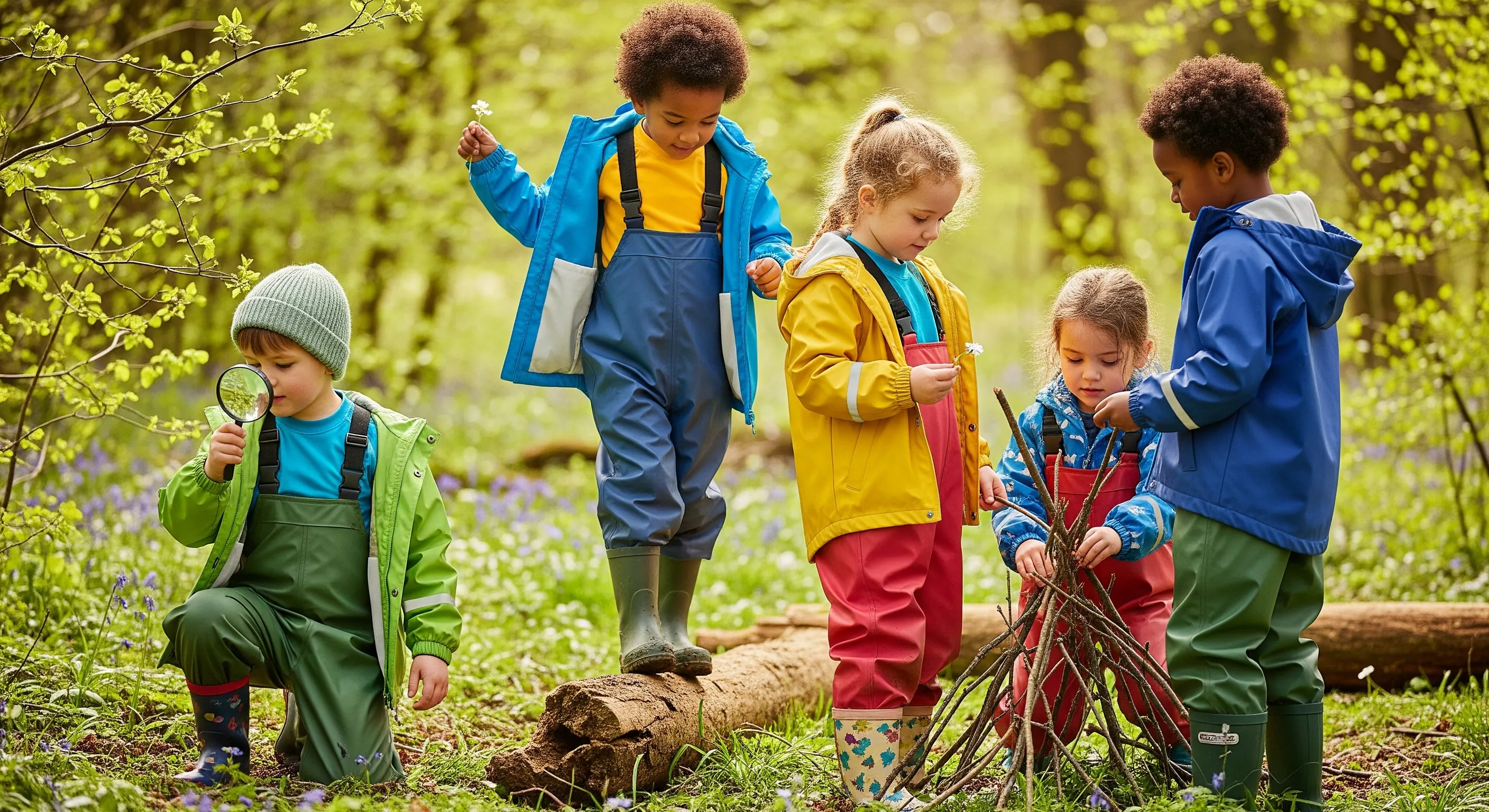
Welcome to the wonderful world of Forest School! It’s a place where mud is a badge of honour, imagination runs wild, and every rustle in the leaves is an invitation to explore. Forest School offers a unique, “child-centred inspirational learning process” that fosters “holistic growth” through regular outdoor sessions. But to truly unlock the magic, ensuring your little adventurer is kitted out correctly is paramount. It’s not just about staving off the shivers or staying dry; the right clothing empowers children to dive headfirst into learning and play, no matter what the British weather throws their way.
You’ll often hear the well-worn adage in Forest School circles:
There is no such thing as bad weather, only bad clothing.
This isn’t just a catchy phrase; it’s a cornerstone of the Forest School philosophy. It speaks to resilience, adaptability, and the joy of embracing nature in all its glorious, sometimes soggy, forms. This mindset encourages us to see weather not as a barrier, but as another element of the adventure. By dressing children appropriately, we remove a significant hurdle to consistent outdoor engagement, which is vital for the long-term developmental benefits that Forest School provides.
Looking for a quick overview?
This is a comprehensive guide, but if you’re short on time, check out our Clothing Advisor Tool for a quick, interactive way to get tailored recommendations for your child’s Forest School and outdoor clothing needs.
This guide is here to demystify the art of dressing your child for their UK Forest School escapades, offering a clear, season-by-season roadmap to the best clothes for outdoor learning in forest school. If you’re new to this wonderful approach to learning, discover more about its enriching principles.
The Golden Rules of Forest School Fashion: Layer Up!
The Secret Weapon: The Layering System
When it comes to dressing for the famously fickle UK climate and the active, engaging days at Forest School, the layering system is your undisputed champion. It’s a simple yet profoundly effective approach that keeps children comfortable, dry, and ready for anything. The principle involves three key layers, each with a specific job:
Base Layer (Closest to the skin):
- Function: This layer’s primary role is to wick moisture – specifically sweat – away from your child’s skin. This keeps them dry and prevents that chilly, damp feeling that can quickly spoil an adventure.
- Best Materials: Opt for wool, particularly soft merino wool, or synthetic fabrics like polyester or polypropylene. Wool is a superstar because it continues to provide warmth even if it gets a bit damp.
- Crucially, Avoid: Cotton! This is a common pitfall. Cotton acts like a sponge, absorbing moisture and holding it next to the skin. This makes your child feel cold and clammy, especially once they stop their energetic play.
Mid Layer (Insulation):
- Function: This layer is all about insulation, trapping body heat to keep your little one warm. Often, a couple of thinner mid-layers are more effective and versatile than one very bulky garment.
- Best Materials: Fleece is a popular and practical choice, known for its warmth and quick-drying properties. Wool jumpers or even lightweight down or synthetic down vests can also work well as mid-layers.
- Adaptability: The beauty of the mid-layer is its flexibility. You can easily adjust the thickness or number of mid-layers depending on the outside temperature and how active your child is being.
Outer Layer (Protection):
- Function: This is your child’s shield against the elements – wind, rain, and snow. It absolutely must be waterproof and windproof. Breathability is a highly desirable feature too, as it allows moisture vapour from the inner layers to escape, preventing that clammy feeling from the inside.
- Best Materials: Look for good quality waterproof fabrics, often with brand names like Gore-Tex, or a company’s own waterproof technology. Critically, check for taped or sealed seams, as this is what makes a garment truly waterproof rather than just water-resistant.
- Considerations: Durability is essential. Forest School clothing needs to withstand mud, climbing, and enthusiastic play.
Benefits of Layering: The layering system isn’t just a set of rules; it’s a strategy that offers significant advantages:
- Adaptability: The UK weather can change in an instant. Layers allow for quick adjustments throughout the day.
- Temperature Regulation: Children can easily add or remove layers to maintain a comfortable body temperature, preventing overheating during active play or chilling during quieter moments.
- Dry Comfort: Effective layering keeps children dry from the inside (by wicking sweat) and from the outside (by repelling rain and snow). Understanding these layers is a cornerstone of our blog and ensuring your child gets the most from their sessions.
| Layer | Primary Function | Best Materials (Examples) | Key Material to Avoid | Why it Matters for Forest School |
|---|---|---|---|---|
| Base Layer | Wicks sweat away from skin | Merino wool, polypropylene, polyester (thermals) | Cotton | Prevents child becoming cold and damp from perspiration during active play; maintains comfort. |
| Mid Layer | Traps body heat for insulation | Fleece (jackets, jumpers), wool, thin down/synthetic vest | Provides warmth that can be easily adjusted by adding/removing items as conditions change. | |
| Outer Layer | Protects from wind, rain, and snow | Waterproof & windproof fabrics (e.g., Gore-Tex, PU coated nylon/polyester) with sealed seams | Keeps child dry and protected from external elements, crucial for comfort and preventing chills. |
Beyond physical comfort, the process of layering offers subtle developmental benefits. When children learn to recognise if they are too hot or too cold and begin to adjust their own layers (with guidance), they are developing an understanding of their own bodies and how to manage their comfort. This fosters independence and self-regulation skills, valuable lessons that extend far beyond the woods. Similarly, for parents, grasping the layering system can be incredibly empowering. It reduces anxiety about a child being uncomfortable or unsafe in unpredictable weather, fostering confidence and encouraging greater support for all kinds of outdoor play.
Dressing for the Seasons: Your Year-Round UK Forest School Wardrobe
The UK is blessed with four distinct seasons, each bringing its own unique charm and weather patterns to our Forest School adventures. While adaptability is always key, understanding the typical conditions for each season will help you fine-tune your child’s outdoor wardrobe. A crucial year-round principle, echoed by many Forest School leaders, is that long trousers are preferable to shorts throughout the year for protection against scratches, stings, and ticks. Similarly, long sleeves are always recommended, even in warmer weather, to minimise risks from stinging nettles, biting insects, and the sun.
Spring Sensations (March-May): Ready for Sun, Showers, and Surprises!
Typical Weather: Spring in the UK can be a delightful mix – often calm and dry, but notorious for delivering “all weather in one day.” Expect sunshine, sudden showers, and temperatures that can swing quite a bit. The days are getting longer and warmer, but the ground can still hold a chill from winter.
Clothing Focus: Versatility is the name of the game. Your child will need layers that can be easily added or removed as the day unfolds. Spring conditions truly highlight the genius of the layering system; a single bulky layer just won’t cut it when the weather is so changeable. Successfully managing comfort by adjusting layers on a spring day can build real confidence in the system for both child and parent.
- Base Layer: A lightweight wool or synthetic long-sleeved top and leggings will keep them comfortable.
- Mid Layer: A fleece jacket or a woolly jumper is ideal. It’s wise to pack an extra light fleece in their bag, just in case.
- Outer Layer: Good quality, lightweight, and fully waterproof jacket and waterproof trousers or dungarees are essential. Unlined versions are often sufficient for spring’s milder temperatures.
- Footwear: Wellies are great for puddles, or sturdy waterproof walking boots for more support on uneven ground. Plan for two pairs of socks – a thin cotton or synthetic base sock, with a thicker wool or cosy “bed sock” on top for warmth and cushioning.
- Accessories: A light hat that can cover the ears is useful if it’s a bit nippy. Gloves might still be needed on colder spring mornings.
- Spares: Absolutely essential! Pack spare trousers, socks, and a top.
Key Takeaway: Spring in the UK often means ‘all weather in one day’ – layers are your best friend!
Summer Adventures (June-August): Sun Safety, Puddle Jumps, and Cool Comfort
Typical Weather: Summer brings the promise of the hottest temperatures and the sunniest days. However, don’t be caught out – the UK summer can also deliver impressive downpours and thunderstorms, sometimes with little warning.
Clothing Focus: The priorities shift to sun protection and breathability, while still being prepared for those unexpected showers. While it might seem instinctive to reach for shorts and t-shirts, Forest School wisdom often suggests otherwise for protection. The key here lies in material choice. Lightweight, breathable, and light-coloured long clothing can offer protection from sun, scratches, and insects without causing overheating.
- Tops & Bottoms: Lightweight, long-sleeved tops and comfortable long trousers (such as jogging bottoms or leggings – avoid denim as it’s slow to dry and cold when wet). These are crucial for protecting delicate skin from the sun, as well as from scratches from brambles, stings from nettles, and bites from insects.
- Outer Layer: Keep an unlined, lightweight waterproof jacket and trousers handy for those inevitable summer showers.
- Footwear: Wellies for puddle jumping, or sturdy, closed-toe shoes that you don’t mind getting muddy. Strictly no sandals or flip-flops, as these offer no protection. One pair of socks is usually fine, but always pack spares.
- Accessories: A wide-brimmed sun hat that stays on well is non-negotiable for sunny days. Sunglasses can also be useful.
- Sun Safety: This is paramount. Apply a high-factor sunscreen (at least SPF30 with good UVA protection) before your child leaves for Forest School. Be sure to understand the Forest School’s policy on reapplication. The NHS advises that children should spend time in the shade between 11 am and 3 pm when the sun is strongest, and that children under 6 months should be kept out of direct strong sunlight. For more detailed guidance, refer to the NHS guidance on sunscreen and sun safety.
- Spares: Pack spare clothing, especially socks and trousers, in case of downpours or enthusiastic muddy play.
Key Takeaway: Stay sun-safe and shower-ready for summer fun, remembering that long, light layers offer the best protection!
Autumn Ambles (September-November): Embracing Crisp Air and Colourful Leaves
Typical Weather: As summer fades, autumn brings cooler temperatures, noticeably shorter days, and often, stormier and wetter weather. The ground will likely be consistently muddier. This is a key transition period where summer’s lighter gear might start to feel inadequate. Investing in good quality, robust waterproofs really pays dividends now, as “water-repellent” items may not stand up to persistent autumn rain.
Clothing Focus: Increasing warmth and truly reliable waterproofing become critical for happy explorers.
- Base Layer: A long-sleeved wool or synthetic thermal top and leggings will form a cosy foundation.
- Mid Layer: One or two mid-layers will likely be needed. Think a good fleece jacket and/or a warm jumper. It’s always a good idea to have a light warm jacket, like a fleece zip-up, in their backpack.
- Outer Layer: Durable, fully waterproof, and windproof jacket and waterproof trousers or dungarees are essential. As winter approaches, you might start to consider fleece-lined options for extra warmth.
- Footwear: Wellies will see a lot of action, or consider waterproof insulated boots as the temperature drops. Two pairs of socks are now essential: a thin base layer sock (cotton or synthetic) and a thick wool or thermal sock on top to keep toes toasty.
- Accessories: A warm hat that covers the ears is a must, along with gloves (waterproof if possible, as wet hands get cold very quickly).
- Spares: Definitely pack spare trousers, several pairs of socks, and an extra jumper.
Key Takeaway: As the leaves fall and the puddles grow, warmth and robust waterproofing become top priorities for happy explorers.
Winter Wonders (December-February): Keeping Cosy, Dry, and Cheerful in the Cold
Typical Weather: Winter brings the coldest months and the shortest days. Conditions can vary significantly across the UK, from very wet and windy periods to cold, calm, and frosty or even snowy spells. The NHS wisely advises that babies and children under five are more vulnerable in cold weather. Winter isn’t just about piling on any clothes; it’s about the right kind of clothes. A critical distinction for UK parents is between “snowproof” gear (which is often only water-resistant and designed for dry, cold, snowy conditions) and truly “waterproof” gear, which is essential for our typically damp British winters.
Clothing Focus: Maximum warmth, complete and reliable waterproofing, and thorough protection for extremities (head, hands, and feet) are the goals.
- Base Layer: Thermal base layers are non-negotiable. Think a thermal wool or synthetic vest, a long-sleeved thermal top, and thermal leggings. Depending on the severity of the cold, you might even consider two thin base layers. Avoid cotton next to the skin at all costs in winter.
- Mid Layers (plural!): Several layers are key to trapping warm air. For example: over the thermal base top, add a long-sleeved t-shirt, then a fleece jumper, and then perhaps a thicker fleece jacket or an insulated vest. For the bottom half, warm trousers like fleece-lined tracksuit bottoms over thermal leggings work well.
- Outer Layer: This needs to be top-notch. A high-quality, fully waterproof, windproof, and preferably insulated or fleece-lined jacket is essential. For trousers, waterproof and windproof overtrousers or dungarees are a must. All-in-one suits can be excellent for younger children, offering full-body protection. Always check for those crucial sealed seams.
- Footwear: Insulated waterproof boots are the best choice. This could mean proper snow boots (that are actually waterproof, not just snow-resistant for powdery snow) or thermal-lined wellies. Multiple pairs of warm socks (wool or thermal are best) are absolutely critical. A common strategy is a thin wool base sock, with a thick wool or thermal sock on top. Crucially, ensure boots are roomy enough to accommodate these extra socks without constricting circulation, as tight boots will make feet colder.
- Accessories: A warm hat that fully covers the ears (wool or fleece is ideal), a neck warmer or snood (excellent for sealing out drafts without dangling ends that can catch), and waterproof, warm mittens or gloves are vital. Ski-type mittens are often recommended as they keep fingers together for warmth and are easier for little ones to manage than gloves. Pack spares, especially for gloves, as they can get wet quickly.
- Spares: An extensive spares bag is a winter lifesaver: extra jumpers, thermal layers, multiple pairs of socks, and spare gloves are highly recommended. For general advice on staying well during colder months, consult the NHS advice on keeping warm and well.
Key Takeaway: With the right thermal layers, top-notch waterproofs, and cosy accessories, the frosty forest becomes a magical wonderland!
Essential Extras & Top Tips for Your Forest School Kit List
Beyond the seasonal specifics, a few extra items and handy tips can make all the difference to your child’s comfort and your peace of mind. These practical pointers address common, real-world concerns and can transform your approach from simply providing a clothing list to creating a truly effective and manageable Forest School kit.
Footwear Focus: Wellies, Boots, and Happy Feet
Wellington boots are a Forest School staple, perfect for splashing in puddles. However, they can be quite cold, especially in autumn and winter, and often offer limited support on uneven or slippery ground. For more challenging terrain or colder conditions, sturdy, waterproof walking boots can be a better investment, providing more warmth, ankle support, and better grip. Regardless of the type of boot, good socks are absolutely paramount. As mentioned throughout the seasonal guides, two pairs are often recommended – a thin inner sock (wool or synthetic) to wick moisture, and a thicker outer sock (wool or thermal) for cushioning and warmth. Always ensure that boots are not too tight when worn with extra socks, as this can restrict blood flow and ironically make feet feel colder. A golden rule for rainy days: Do not tuck waterproof trousers into wellies! This common mistake creates a direct channel for rainwater to run straight down into the boot, resulting in soggy, unhappy feet. Trousers should always go over the top of wellies.
Don’t Forget Hats, Gloves & Scarves!
These accessories are small but mighty in the fight against the cold.
- Hats: A significant amount of body heat can be lost through the head, so a hat is essential for warmth, especially in autumn and winter. In summer, a wide-brimmed sun hat is vital for sun protection.
- Gloves/Mittens: Waterproof mittens are generally the best choice for younger children. They keep fingers together, which is warmer than individual finger slots in gloves, and they are often easier for little ones to put on themselves. Simple knitted or woollen gloves are a poor choice for wet conditions as they soak up water quickly and make hands very cold. Always pack a spare pair (or two!) of gloves or mittens, as they are often the first things to get wet and muddy.
- Scarves/Neck Warmers: A neck warmer or snood is an excellent addition, particularly in winter. It seals out cold drafts around the neck and can be pulled up over the chin and mouth for extra warmth, without the hazard of long, dangling scarf ends that could catch on branches.
The All-Important Spares Bag
If there’s one thing that’s guaranteed at Forest School, it’s that children will get wet and/or muddy – it’s all part of the fun and learning!. A well-stocked spares bag is therefore not just a good idea, it’s crucial. Having a dry set of clothes to change into means your child can quickly get comfortable again and continue to enjoy their session without feeling miserable. Your spares bag should contain at least one full change of clothes: a top, trousers, underwear, and especially socks – pack multiple pairs of these. In colder weather, include an extra jumper or fleece and spare thermal layers if you have them.
Mud, Glorious Mud! (And How to Handle It)
Forest School embraces messy play, and mud is often a star attraction! This kind of sensory exploration is hugely beneficial for children’s development. Don’t let the thought of mud put you off.
- Waterproofs are your best friend: Good quality waterproofs, especially dungaree-style trousers for younger children, make mud entirely manageable. They provide excellent coverage and can be easily wiped down or rinsed.
- A surprising cleaning tip: You don’t need to machine wash waterproofs every time your child uses them. In fact, it’s often better to let mud dry and then simply brush it off. Frequent machine washing, especially with detergents, can reduce the effectiveness of the waterproof coating over time. If they really need a clean, try rinsing them in a large bucket or even the bath. This practical advice can significantly extend the life of expensive outdoor gear.
Dressing for Forest School on a Budget
Equipping your child for Forest School doesn’t have to break the bank. Here are a few tips for kitting them out economically:
- Second-hand Savvy: Charity shops, nearly-new sales, and online marketplaces can be goldmines for children’s outdoor clothing. Many items are outgrown long before they are worn out.
- Sales Shopping: Keep an eye out for end-of-season sales at outdoor retailers.
- Prioritise Wisely: If your budget is tight, invest your money where it matters most. A really good quality waterproof outer layer (especially waterproof trousers or dungarees, as these tend to get the most wear and tear) and good thermal base layers for winter are key. Mid-layers can often be standard fleeces or jumpers your child already owns.
- Durability vs. Price: Sometimes, paying a little more for a durable, well-made item can be better value in the long run than buying cheap alternatives that wear out quickly and need frequent replacement. It can be a “false economy to buy cheaper lightweight brands” if the clothing will be subjected to robust outdoor play.
- Hand-Me-Downs: Forest School is the perfect destination for hand-me-down clothes!
- Community Swaps: Some schools or parent groups organise clothing swaps, which can be a fantastic way to pass on outgrown items and pick up what you need. Worried about the mess or the potential cost? We help debunk some common myths on our blog which might ease your concerns.
Seeing is Believing: Clothing Tips in Action
Sometimes, seeing is believing, especially when it comes to practical tasks like layering or understanding how specific outdoor gear performs.
Understanding how to layer clothes effectively is key for a comfortable day outdoors in the UK. This video, while focused on hiking with kids, excellently demonstrates the core layering principles – base, mid, and outer layers – that are directly applicable and super helpful for Forest School adventures:
See how the right kit, like fantastic waterproof dungarees and mittens, keeps little explorers happy and dry at Forest School! The following video gives a great demonstration of specific items like waterproof dungarees and mittens in action:
Conclusion: Ready for Every Forest School Adventure!
Kitting out your child with the right clothing is more than just a practical task; it’s the key to unlocking the full spectrum of benefits that Forest School offers. It’s about ensuring they are warm, dry, and comfortable enough to fully immerse themselves in the joy of discovery, the thrill of exploration, and the quiet wonder of connecting with nature. As the Forest School Association highlights, this approach aims to “promote the holistic development of all involved, fostering resilient, confident, independent and creative learners”. With the seasonal guidance and layering wisdom shared in this post, you can feel confident that your little explorer is well-prepared to learn, play, and thrive in the great outdoors, whatever the British weather may bring. This preparation is not just about physical comfort; it supports their journey to becoming more resilient, self-assured, and curious individuals with a deep and lasting appreciation for the natural world.
Ready to find a fantastic Forest School near you? Explore the Forest School Finder directory! For more insights into the amazing advantages of this approach, check out our article on Forest School benefits for beginners. Browse more articles on our blog for your outdoor learning journey.
Frequently Asked Questions (FAQ)
Here are answers to some common questions parents have about dressing children for Forest School:
Q: What’s the single most important piece of clothing for Forest School? A: While all layers play their part, a high-quality, fully waterproof and windproof outer layer (both jacket and trousers or dungarees) is arguably the most crucial piece for UK weather. If children get wet, they become cold very quickly, which can significantly impact their enjoyment and even lead to them needing to end their session early. When combined with an effective non-cotton base layer to manage perspiration, this outer shield forms a strong defence against the elements.
Q: Are wellies always the best footwear option for Forest School? A: Wellies are certainly popular and absolutely brilliant for jumping in puddles! However, they can be quite cold, especially in autumn and winter, and often offer less foot support and grip than sturdy, waterproof walking boots, particularly on uneven or muddy terrain. If your child is wearing wellies, ensuring they fit well with two pairs of warm socks (a thin inner, thick outer) is vital. Some Forest Schools may specifically recommend walking boots for older children or for sites with more challenging ground. It’s always a good idea to check with your specific Forest School provider for their preference.
Q: How many layers does my child actually need in winter? A: There isn’t a magic number, as it really depends on the specific weather conditions on the day (temperature, wind chill, dampness), your child’s individual activity level, and how much they personally feel the cold. However, a good rule of thumb for UK winters is to aim for at least three key layers: a thermal base layer (wool or synthetic, next to the skin), one or ideally two insulating mid-layers (e.g., a fleece top, followed by a fleece jacket or thin insulated vest), and a fully waterproof and windproof outer layer. It’s always better to send them with an extra layer they can remove if they get too warm, rather than them not having enough to stay comfortable.
Q: My child hates wearing hats and gloves! Any tips? A: This is a very common challenge! Firstly, try involving your child in choosing their hat and gloves – if they like the colour or design, they might be more willing to wear them. Opt for soft, comfortable materials; fleece-lined hats are often well-received, and soft mittens can be less restrictive and warmer than bulky gloves. Make putting them on part of a fun “getting ready for adventure” routine. Ensure items fit well and aren’t itchy or too tight. For hands, as mentioned, waterproof mittens are often better tolerated by younger children and keep hands warmer than gloves with individual fingers. Sometimes, a cosy neck warmer or snood pulled up can offer some protection to the lower face and ears if a hat is truly resisted, but a hat is always best for overall heat retention in cold weather. Leading by example is also powerful – if they see you wearing your hat and gloves, they might be more inclined to wear theirs!
